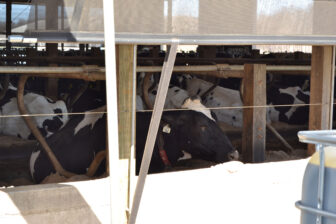
Cutline: MOO-ville Creamery in Nashville, Michigan, installed fans in their barns to keep the cows cooler during hot days. Image: Shelby Frink
By Shelby Frink
Researchers found that increasing temperatures from climate change may slightly increase milk production, despite the heat stress on cows.
Dairy cows produce less milk when they get too hot, said Rigoberto Lopez, the corresponding author of the study and a professor of Agricultural and Resource Economics at the University of Connecticut. However, hot temperatures stimulate the growth of plants that cows eat to produce milk.
The loss of milk production through heat stress is offset by the increase in feed production, according to the study published in March in the journal Agricultural and Resource Economics Review.
This is because the more cows eat, the more milk they can produce, Lopez said.
It’s the first U.S. study to analyze that tradeoff, he said. Another study in Spain came to the same conclusion.
Researchers focused on extreme temperatures, Lopez said. “We wanted to see the effects of climate change on cows.”
Another benefit of a warming climate is that feed production increased over a 10-year span because the growing season lengthened over time, said Chris Laughton, a co-author of the study and an agricultural economist at Farm Credit East, a Connecticut financial services network.
Increased feed production also has economic implications.
Feed is the bulk of the cost of dairy production, Lopez said. Whatever happens to feed will affect the profitability of farms.
Feed is a dairy farm’s biggest expense, especially between the increase in fertilizer costs and the cost of the land to grow it, said Eric Westendorp, a dairy farmer at MOO-ville Creamery in Nashville, Michigan.
The benefits from increased feed production are modest, Laughton said.
According to the study, for every 1% increase in 90-degree days, there is a 0.0024% increase in milk production when the cows eat the additional feed.
By 2080, the number of days over 90 degrees will increase 10-fold for northern areas closer to lakes, Lopez said. This includes Michigan and northern New York.
Westendorp hasn’t seen an impact yet, but noted there is a 5-to-7-pound decrease in milk produced by each cow in July and August due to heat stress.
It’s difficult to see the true effects of climate change because farm efficiency increases with new technology and changing practices, Laughton said. One of the best ways for farmers to mitigate the effects of climate change is to focus on cow comfort during hot days.
MOO-ville Creamery is a medium-sized dairy farm with 500 cows, but only about 215 are active milk producers while the rest are either pregnant or calves, Westendorp said. The farm combats heat stress with fans and shade cloths in barns and by laying down sand for the cows.

Cutline: MOO-ville Creamery in Nashville, Michigan, puts shades on the sides of the barns to keep the sun off of their dairy cows. Image: Shelby Frink
The farm hopes to implement a robotic soaking system within the next couple of summers, Westendorp said. It will use motion sensors to detect the cows’ location before spraying them down with water to cool them off.
Increasing efficiency can also help mitigate the economic effects of climate change, Lopez said. Larger farms are usually the most efficient.
Four robotic milkers increase MOO-ville’s efficiency by decreasing labor costs and improving milk production, Westendorp said.
They increase daily milk production by 3-to-5-pounds per cow, according to the University of Minnesota.
Only 55 of the 1,206 dairy farms in Michigan used robotic milkers in 2020, the Michigan Department of Agriculture and Rural Development reported.
Dairy farmers do not have a reason to be overly concerned about climate change in terms of heat, Laughton said. The bigger concern is that climate change means that farmers are getting rainfall in a more concentrated manner.
That means they should look at irrigation and drainage technology because they’re going to go through cycles of having too much water and not enough, “sometimes even in the same season,” Laughton said. This will negatively impact feed production.
This study did not focus on the effects of changing precipitation patterns on dairy farms, Laughton said. That would be difficult to quantify because there are many variables.